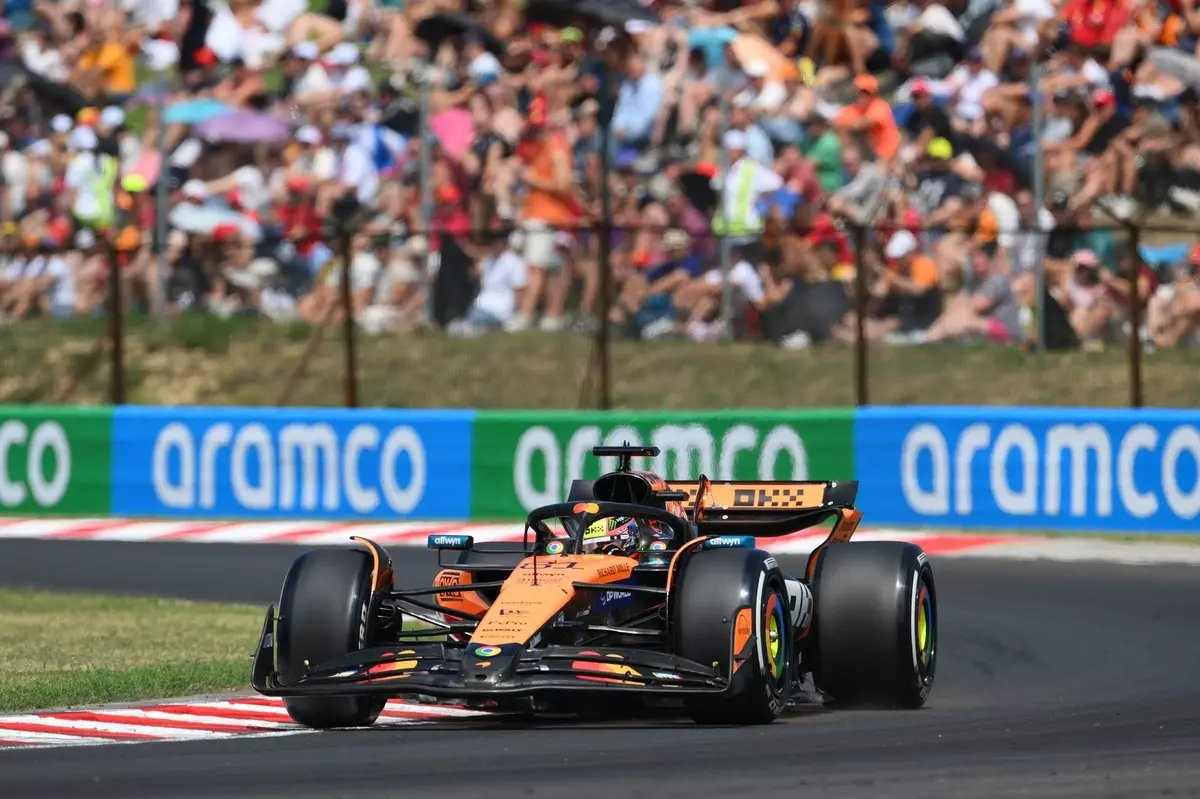The final practice session of the Hungarian Grand Prix showcased a remarkable shift in the pecking order, primarily driven by McLaren’s audacious approach to tire management and race pace mastery. Oscar Piastri’s daring decision to switch to new soft tires in the critical last moments of implementing an aggressive lap exemplifies strategic boldness that can redefine race outcomes. Such a move underscores the importance of timing and psychological grit in Formula 1, where a fraction of a second can translate into championship advantage. Piastri’s stunning 1m14.916s serves as a testament to his skill and to McLaren’s continued evolution as a top contender — not just in raw speed, but in their ability to challenge the traditional dominators with gutsy tactics.
Norris’s close pursuit adds a compelling narrative about the strength of McLaren’s driver lineup—both capable of maximizing the car’s potential under pressure. Their back-to-back performance reveals a team that’s not only focused on hardware but also on the psychological resilience necessary to capitalize when it matters most. In a sport often dictated by delicate balance and fleeting opportunities, McLaren’s confidence resonates as a statement: they are firmly in the hunt, ready to seize opportunities with both calculated risk and raw speed.
Mastery in the Shadows of Red Bull and Ferrari
While Red Bull’s Max Verstappen and Ferrari’s Charles Leclerc maintained their presence at the top of the timesheets, their efforts fell slightly short of the audacious excellence displayed by McLaren. Verstappen’s 1m16.202s and Leclerc’s 1m16.406s reflect an intricate process of fine-tuning, with Red Bull still grappling with overall balance issues that could hamper their qualifying ambitions. Ferrari, despite showing promising pace, continues to falter slightly, as Leclerc’s consistent third place underscores a frustrating pattern—capable but not quite there when it counts.
The key takeaway is that speed alone isn’t enough in today’s F1 environment—ability to adapt, to push with precision under a spectrum of conditions, and to execute strategic gambles determine who emerges at the summit. McLaren’s performance in the final moments illustrates this truth vividly: speed is necessary, but timing and mental clarity are equally vital, especially when racing against teams with seemingly superior raw pace like Red Bull.
The Rising Contenders and the Shifting Landscape
The session also highlighted the emergence of teams like Mercedes and Sauber, whose drivers pushed into notable positions despite the ongoing struggle with car balance. George Russell’s eighth-place finish, coupled with Nico Hülkenberg’s ninth, demonstrates that consistency and smart lap execution can provide meaningful leverage in qualifying—and, potentially, the race. The surprise inclusion of rookie Andrea Kimi Antonelli in the top five signals that the grid’s depth continues to diversify, with fresh talent proving they can punch above their weight.
Meanwhile, the struggle for Red Bull and the midfield teams to find stability underlines an evolving dynamic in F1. The balance issues facing Max Verstappen and Yuki Tsunoda’s comparatively weaker showing emphasize that speed is not uniform across qualifying simulations until teams unlock the full potential of their setups. This ongoing challenge presents opportunities for strategic ingenuity, where teams willing to experiment and push the limits could upset the status quo.
Implications for the Race and the Future of F1 Strategy
From a strategic perspective, the Hungarian GP final practice underscores the importance of bold decision-making in the face of uncertainty. McLaren’s aggressive rear-shift to fresh soft tires in the closing minutes exemplifies how calculated risks can pay enormous dividends. It suggests that team strategists must be agile and anticipatory, capable of adapting to evolving track conditions and competitor moves in real time.
The broader takeaway is a reaffirmation that modern F1 is a game of milliseconds—where mental resilience, tactical risk, and adaptive precision converge. As teams refine their setups and drivers learn to push the limits more consistently, the outcome of qualifying sessions such as this provides valuable clues about potential race-day surprises. McLaren’s apparent breakthrough not only signals a shift in this race but could mark an inflection point in the championship, pushing other teams to reconsider their approaches and embrace a more aggressive, risk-tolerant mindset.
In the high-stakes arena of Grand Prix racing, pushing boundaries with strategic innovation and fearless execution often spells the difference between victory and obscurity. The Hungarian practice results serve as a compelling reminder: in Formula 1, boldness isn’t just an attitude; it’s an essential ingredient for victory.

